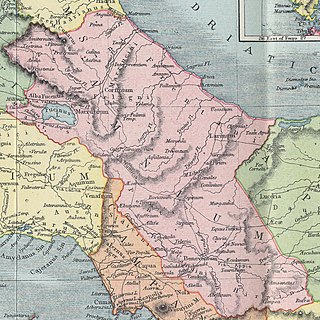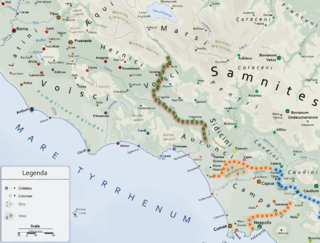
Campania is an administrative region of Italy; most of it is in the south-western portion of the Italian peninsula, but it also includes the small Phlegraean Islands and the island of Capri. The capital of the Campania region is Naples. As of 2018, the region had a population of around 5,820,000 people, making it Italy's third most populous region, and, with an area of 13,590 km2 (5,247 sq mi), its most densely populated region. Based on its GDP, Campania is also the most economically productive region in southern Italy and the 7th most productive in the whole country. Naples' urban area, which is in Campania, is the seventh most populous in the European Union. The region is home to 10 of the 58 UNESCO sites in Italy, including Pompeii and Herculaneum, the Royal Palace of Caserta, the Amalfi Coast and the Historic Centre of Naples. In addition, Campania's Mount Vesuvius is part of the UNESCO World Network of Biosphere Reserves.

Magna Graecia was the name given by the Romans to the coastal areas of Southern Italy in the present-day regions of Calabria, Apulia, Basilicata and Campania; these regions were extensively populated by Greek settlers. These settlers, who began arriving in the 8th century BC, brought with them their Hellenic civilization, which left a lasting imprint in those territories, as it did in the culture of ancient Rome. They also influenced the native peoples, such as the Sicels, or the Oenotrians, who became Hellenised after they adopted the Greek culture as their own.

The Appian Way is one of the earliest and strategically most important Roman roads of the ancient republic. It connected Rome to Brindisi, in southeast Italy. Its importance is indicated by its common name, recorded by Statius, of Appia longarum... regina viarum.

The Osci were an Italic people of Campania and Latium adiectum during Roman times. They spoke the Oscan language, also spoken by the Samnites of Southern Italy. Although the language of the Samnites was called Oscan, the Samnites were never referred to as Osci, nor were the Osci called Samnites.

The First, Second, and Third Samnite Wars were fought between the Roman Republic and the Samnites, who lived on a stretch of the Apennine Mountains south of Rome and north of the Lucanian tribe.

Samnium is a Latin exonym for a region of Southern Italy anciently inhabited by the Samnites. Their own endonyms were Safinim for the country and Safineis for the people. The language of these endonyms and of the population was the Oscan language. However, not all the Samnites spoke Oscan, and not all the Oscan-speakers lived in Samnium.

The Samnites were an ancient Italic people who lived in Samnium, which is located in modern Abruzzo in south-central Italy. An Oscan-speaking people who probably originated as an offshoot of the Sabines, they formed a confederation consisting of four tribes: the Hirpini, Caudini, Caraceni, and Pentri. Although they allied with Rome against the Gauls in 354 BC, they later became enemies of the Romans and fought them in a series of three wars; despite an overwhelming victory at the Battle of the Caudine Forks, the Samnites were eventually subjugated. Although severely weakened, the Samnites would still side against the Romans, first in the Pyrrhic War and then with Hannibal in the Second Punic War. They also fought from 91 BC in the Social War and later in the civil war as allies of the Roman consuls Papirius Carbo and Gaius Marius against Sulla, who defeated them and their leader Pontius Telesinus at the Battle of the Colline Gate. They were eventually assimilated by the Romans and ceased to exist as a distinct people.

Lucania was a historical region of Southern Italy. It was the land of the Lucani, an Oscan people. It extended from the Tyrrhenian Sea to the Gulf of Taranto.

Paestum was a major ancient Greek city on the coast of the Tyrrhenian Sea in Magna Graecia. The ruins of Paestum are famous for their three ancient Greek temples in the Doric order, dating from about 550 to 450 BC, which are in an excellent state of preservation. The city walls and amphitheatre are largely intact, and the bottom of the walls of many other structures remain, as well as paved roads. The site is open to the public, and there is a modern national museum within it, which also contains the finds from the associated Greek site of Foce del Sele.

A fish plate is a Greek pottery vessel used by western, Hellenistic Greeks during the fourth century BC. Although invented in fifth-century BC Athens, most of the corpus of surviving painted fish plates originate in Southern Italy, where fourth-century BC Greek settlers, called "Italiotes," manufactured them.
The Hirpini were an ancient Samnite tribe of Southern Italy. While generally regarded as having been Samnites, sometimes they are treated as a distinct and independent nation. They inhabited the southern portion of Samnium, in the more extensive sense of that name, roughly the area now known as Irpinia from their name—a mountainous region bordering on Basilicata towards the south, on Apulia to the east, and on Campania towards the west. No marked natural boundary separated them from these neighboring nations, but they occupied the lofty masses and groups of the central Apennines, while the plains on each side, and the lower ranges that bounded them, belonged to their more fortunate neighbors. The mountain basin formed by the three tributaries of the Vulturnus —the Tamarus, Calor, and Sabatus, which, with their valleys, unite near Beneventum, surrounded on all sides by lofty and rugged ranges of mountains—is the center and heart of their territory. They occupied the Daunian Mountains to the north, while its more southern portion comprised the upper valley of the Aufidus and the lofty group of mountains where that river takes its rise.

The Lucanians were an Italic tribe living in Lucania, in what is now southern Italy, who spoke an Oscan language, a member of the Italic languages. Today, the inhabitants of the Basilicata region are still called Lucani, and so their dialect.

"Ausones", the original Greek form for the Latin "Aurunci", was a name applied by Greek writers to describe various Italic peoples inhabiting the southern and central regions of Italy. The term was used, specifically, to denote the particular tribe which Livy called the Aurunci, but later it was applied to all Italians, and Ausonia became a poetic term, in Greek and Latin, for Italy itself.

South Italian is a designation for ancient Greek pottery fabricated in Magna Graecia largely during the 4th century BC. The fact that Greek Southern Italy produced its own red-figure pottery as early as the end of the 5th century BC. was first established by Adolf Furtwaengler in 1893. Prior to that this pottery had been first designated as "Etruscan" and then as "Attic." Archaeological proof that this pottery was actually being produced in South Italy first came in 1973 when a workshop and kilns with misfirings and broken wares was first excavated at Metaponto, proving that the Amykos Painter was located there rather than in Athens.
The military campaigns of the Samnite Wars were an important stage in Roman expansion in the Italian Peninsula.

Mirror armour, sometimes referred to as disc armour or as chahār-āyneh or char-aina, was a type of cuirass used mainly in Asia, the Middle East, and Eastern Europe; including India, Persia, Tibet, Russia, and the Ottoman Empire. It literally translates to "four mirrors" which is a reflection of how these pieces looked, which resembles four metal discs or rectangular armour plates. Mirror armor was used in some cultures up to the 20th century.

The Dendra panoply or Dendra armour is an example of Mycenaean-era panoply made of bronze plates uncovered in the village of Dendra in the Argolid, Greece.

In classical antiquity, the muscle cuirass, anatomical cuirass, or heroic cuirass is a type of cuirass made to fit the wearer's torso and designed to mimic an idealized male human physique. It first appears in late Archaic Greece and became widespread throughout the 5th and 4th centuries BC. Originally made from hammered bronze plate, boiled leather also came to be used. It is commonly depicted in Greek and Roman art, where it is worn by generals, emperors, and deities during periods when soldiers used other types.

The Ksour Essef cuirass is an ancient breastplate found in a Punic tomb in 1909 not far from Ksour Essef, Tunisia.
Pontius Telesinus was the last independent leader of the Italic Samnites before their annexation by the Roman Republic. A fierce patriot, he was one of the rebel commanders in the Social War against Rome, leading the last remnants of the rebellion in southern Italy after the main uprising had already been suppressed. He intervened in the Roman civil wars of the 80s BC in an attempt to improve his and his people's position, but picked the losing side and was killed in 82 BC following the Battle of the Colline Gate against the Roman general Sulla.

















